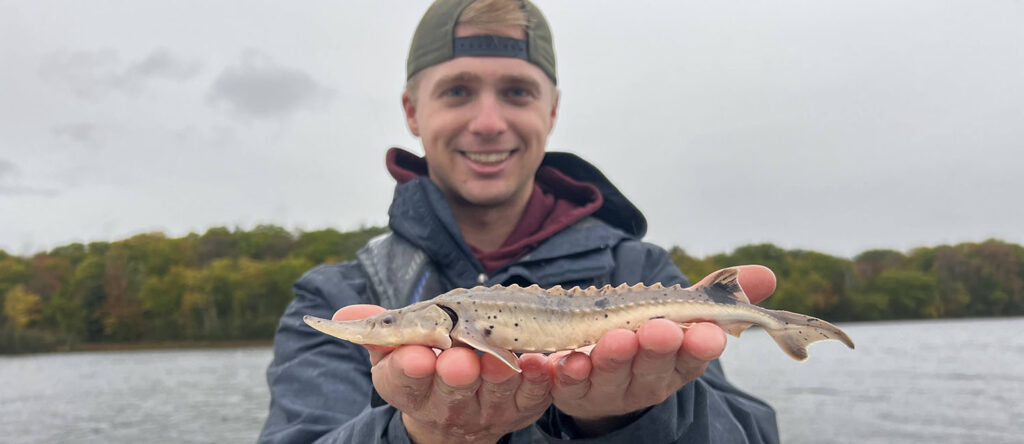
Zach Nordstrom is part of the Lake Sturgeon conservation research at UW-Green Bay. The Freshwater Collaborative is funding undergraduate research at UW-Green Bay that centers on lake sturgeon reproduction, survival during early life stages, and behavior. Students receive hands-on training in the care and raising of lake sturgeon and provide data that is critical to the Menomonee River Fish Passage Project.
Lake sturgeon first evolved around 200 million years ago, around the same time as the dinosaurs. This unique fish species once numbered more than two million. Fish biologists estimate about 3,000 adult fish exist in the Great Lakes proper today.
Wisconsin is an international leader in lake sturgeon conservation. The state’s efforts target sustaining populations that use four major tributaries of Green Bay for reproduction: the Fox, Oconto, Peshtigo and Menominee Rivers. The Freshwater Collaborative is funding undergraduate research at UW-Green Bay that centers on lake sturgeon reproduction, survival during early life stages and behavior.
“Because of the evolutionary history of lake sturgeon, and their cultural significance in the region, no one really wants to see the species at risk of extinction,” says Patrick Forsythe, an associate professor of biology at UW-Green Bay. He has studied lake sturgeon for about 20 years.
Lake sturgeon spawn in rivers, and their larvae need a long stretch of river to provide protective habitat for growth before they move into the bay and then Lake Michigan, where predators abound. The Menominee and Park Mill Dams, located about a mile upstream from Green Bay, restrict reproduction for lake sturgeon living in the bay.
Enter the Menomonee River Fish Passage Project, which allows adult lake sturgeon to access important spawning habitats upstream from the dams. Sturgeon swim into an “elevator” inside the Menominee Dam. They are then moved by truck upstream of the Park Mill Dam to reproduce further up the Menominee River. The adults and juveniles then journey back through several bypass routes in the dams and into the bay.
Using genetic techniques to determine parentage of recently produced larvae emerging from habitat downstream from the Grand Rapids Dam, Forsythe and his team have determined that nearly 90 percent of the fish passed upstream of the two lower dams —and those impeding access to historic spawning sites — reproduce successfully. That’s good news for conservation efforts, but it’s only on part of the equation.
With funding from the Freshwater Collaborative and supporting partners including the Fish and Wildlife Restoration Act and We Energies, Forsythe and students in his lab are looking at survival rates. Do juveniles in their first year of life survive the journey? If so, which routes do they take through the dams before entering the Bay of Green Bay?
Students are collecting larvae and raising them until they are large enough to surgically implant acoustic and PIT transmitters. The transmitters will track the fish as they move downstream. The collected data will inform whether river and dam management can improve survival rates of juveniles as they journey downstream. This knowledge could improve overall conservation efforts.
Forsythe says students are directly involved in every aspect of the project. This includes experimental design, setting up the tailer to collecting larvae, inserting transmitters, and caring for the fish before they are released and tracking can commence.
“This project gives students a lot of experiences,” he says. “My students are in a really good position to apply for graduate school or get their first job. I’m really proud of that.”
The students routinely participate in planning sessions with working professionals, giving them networking opportunities and insight into the complexities of large collaborative projects.
Partners include USGS, Wisconsin Cooperative Fishery Research Unit, U.S. Fish and Wildlife Service, Wisconsin DNR, Michigan DNR, the cities of Menominee and Marinette, WE Energies and the Mitigation Enhancement Fund, Menominee Indian Tribe of Wisconsin, Michigan Hydropower Reform Coalition, River Alliance of Wisconsin, and Eagle Creek Renewable Energy (owner and operator of the Menominee and Park Mill Dams) and fish biologists from Carlton University in Canada.
Lauren Klawiter is an undergraduate working on the project. She gained so much experience last year that she snagged a summer internship with Colorado State University. She is working with the Environment for Management of Military Lands at Fort McCoy.
“I will be using my skills from last summer and adding additional skills, which I am extremely excited for,” she says. “I have really enjoyed my experiences with fish. I hope to obtain a position working at a fishery or potentially with the DNR.”
Klawiter shared her research at Research in the Rotunda in March 2024. She also presented it at the 154th National American Fisheries Society Conference, attended by more than 3,000 people. Graduate students Steve Hughes and Zach Nordstrom presented posters at the AFS conference as well.
In 2023, students helped collect and care for about 1,500 lake sturgeon. This summer, three new undergraduates and a graduate student joined the team to continue the research. The project is expected to wrap up at the end of 2025 when results will be submitted for publication.
Written by Freshwater Collaborative of Wisconsin
Link to original story: https://freshwater.wisconsin.edu/lake-sturgeon-conservation-research/
